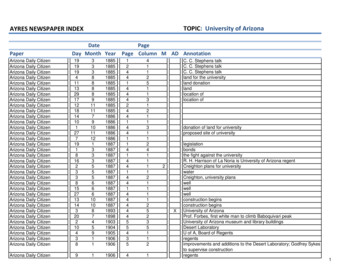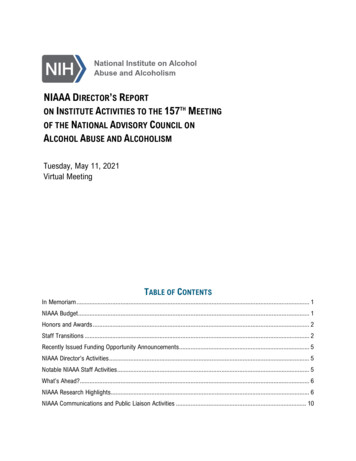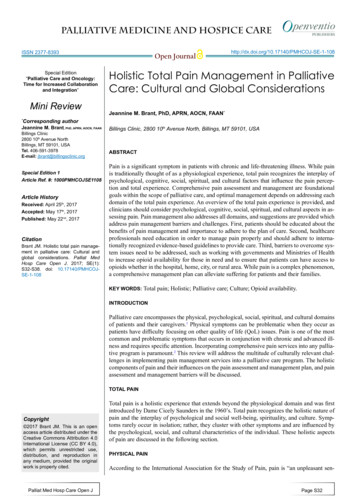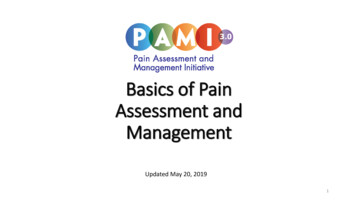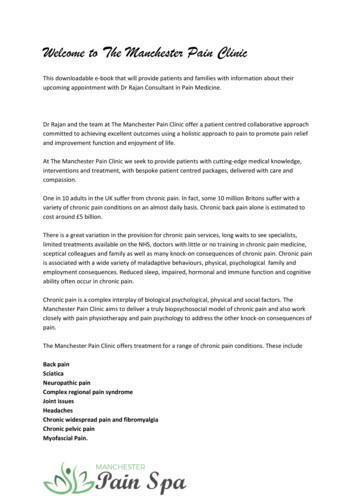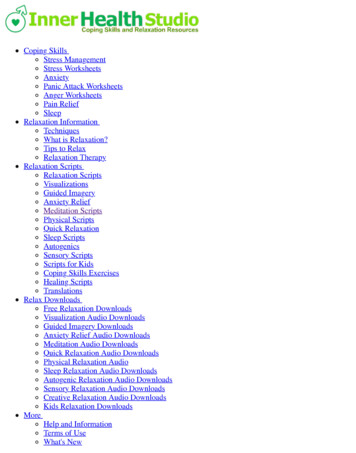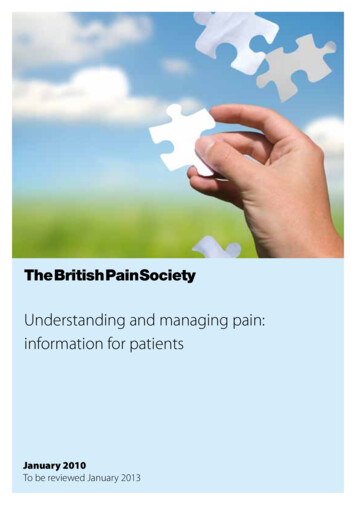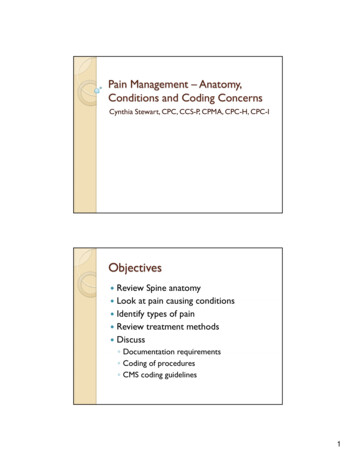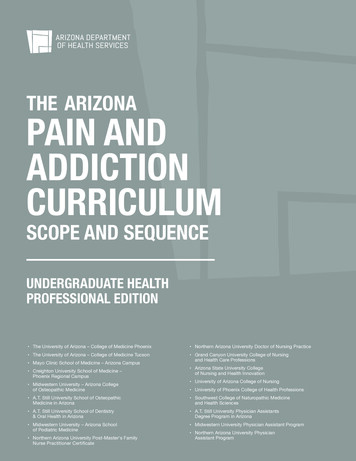
Transcription
THE ARIZONAPAIN ANDADDICTIONCURRICULUMSCOPE AND SEQUENCEUNDERGRADUATE HEALTHPROFESSIONAL EDITION The University of Arizona – College of Medicine Phoenix Northern Arizona University Doctor of Nursing Practice The University of Arizona – College of Medicine Tucson Grand Canyon University College of Nursingand Health Care Professions Mayo Clinic School of Medicine – Arizona Campus Creighton University School of Medicine –Phoenix Regional Campus Midwestern University – Arizona Collegeof Osteopathic Medicine Arizona State University Collegeof Nursing and Health Innovation University of Arizona College of Nursing University of Phoenix College of Health Professions A.T. Still University School of OsteopathicMedicine in Arizona Southwest College of Naturopathic Medicineand Health Sciences A.T. Still University School of Dentistry& Oral Health in Arizona A.T. Still University Physician AssistantsDegree Program in Arizona Midwestern University – Arizona Schoolof Podiatric Medicine Midwestern University Physician Assistant Program Northern Arizona University Physician Northern Arizona University Post-Master's FamilyAssistant ProgramTHE ARIZONAPAIN ANDADDICTION CURRICULUM azhealth.gov/curriculumNurse PractitionerCertificate1
June 25, 2018Dear Clinical Educators of Arizona:It has been nearly a year since there was a Statewide Public Health Emergency declared in the State of Arizona due tothe opioid epidemic. With more than two Arizonans dying every day from an opioid overdose, multiple stakeholders,including clinical educators, came together to change the paradigm of pain and addiction management here in Arizona.While the Arizona Department of Health Services proposed a statewide curriculum as part of its response to the opioidepidemic, the Arizona Curriculum on Pain and Addiction that your programs have jointly developed has surpassed allexpectations. Your collaboration across program types (MD, DO, NP, PA, DMD, ND, DPM) to link pain and addiction,to use a socio-psycho-biological model and to stress destigmatization and clinician introspection is something thathas not been attempted or seen before in the nation.We hope that your program is able to implement this curriculum into your educational structures as soon aspossible. This curriculum strives to fundamentally change the culture of pain and addiction – with new definitions, newemphases and the newest evidence represented in a forward-thinking approach. It will take years to see a difference fromthese efforts, so we need to start now.As participating in the creation and implementation of this Arizona Curriculum, you are part of a bold move to make agenerational, wide-sweeping change to pain and addiction education. Thank you for your innovation, leadership andcommitment. We are proud to be your partners in Arizona.Sincerely,Cara M. Christ, MD, MSDirectorArizona Department of Health ServicesTHE ARIZONA PAIN AND ADDICTION CURRICULUM azhealth.gov/curriculum2
INTRODUCTIONPURPOSEThe Arizona Curriculum on Pain and Addiction represents a large-scale culture shift in the education of the next generation ofprescribers. While it is hoped the curriculum will bring about focused results such as a reduction in the number of opioid-relatedoverdoses, a reduction in opioids prescribed, and an increase in the number of providers able to treat opioid use disorder -- thiscurriculum moves beyond these discrete goals to redefine pain and addiction as interlinked, complex, public health processes,requiring interprofessional care and involvement of the community and health-based systems.BACKGROUNDOn June 5, 2017, Governor Doug Ducey declared a Statewide Public Health Emergency in Arizona due to the Opioid Epidemic.Real time data from the Arizona Department of Health Services Opioid Overdose Surveillance System revealed over one-hundredfatal and nonfatal overdoses being reported each week. There were indications of unsafe and non-evidence-based practices ofsome prescribers and a distinct lack of statewide capacity to manage opioid use disorder. In response to these findings, one of therecommendations from the Department was to create a statewide curriculum for all prescribers on pain and addiction (azhealth.gov/opioidactionplan).METHODSBeginning in January 2018, four meetings were held with Deans and Curriculum Representatives from all eighteen MD, DO, PA, NP,DMD, DPM and ND programs in Arizona. After reviewing the surveillance data and current program curricula, the group used bestpractices from other schools, published theories of pain and addiction education, national trends from the National Pain Strategyand National Academies of Medicine, and input from Arizona pain and addiction specialists to create curriculum drafts that weresystematically reviewed for relevance and scope.As such, a number of forward-thinking concepts were established upon which to build a new statewide curriculum: The link between pain and addiction The destigmatization of pain and addiction The use of a macro- to micro- perspective to pain and addiction (the socio-psycho-biological approach)The evidence-base of pain and addiction careThe influence of the pharmaceutical industry on cliniciansThe focus on clinician and system introspection, both in personal biases and excellence of careINTENDED SCOPEThere are twelve types of clinicians that are authorized to prescribe opioids in the State of Arizona: Doctors of Medicine (MD),Doctors of Osteopathic Medicine (DO), Doctors of Podiatric Medicine (DPM), Doctors of Medicine in Dentistry (DMD), RegisteredNurse Practitioners (RNP), Naturopathic Doctors (ND), Physician Assistants (PA), Doctors of Optometry, Doctors of Homeopathy,and Doctors of Veterinary Medicine.This curriculum is intended for use in the following health educational programs: Undergraduate: MD, DO, DPM, DMD, RNP, ND and PA programsGraduate: RNP programsSTRUCTURE INTENDED USEThe structure of the curriculum is intuitively organized by a set of ten Core Components, each of which is expanded and detailed intospecific Objectives and Key Readings. The subsequent sections list implementation strategies (Toolbox) and assessment mechanisms(Assessment). The last section is a sample mapping of the curriculum to Entrustable Professional Activities (Map), a standardizedcurriculum structure for many programs.This curriculum is intended to be used as the entire set of ten Core Components, rather than choosing individual ones (e.g. teachingonly Core Components #1, #5, #8). The ten Core Components are pertinent to all programs, but the detail of which can be expandedand contracted, accordion-style, as pertinent. This material is likely to be best integrated across the years of training in bothclassroom and clinical settings.Of note, this Faculty Guide, along with the original Arizona Pain and Addiction Curriculum, are public materials. They are nonproprietary and can be used outside of the state in any health educational program. Although permission is not required, emailnotification of programs’ use of the materials is appreciated (azopioid@azdhs.gov).THE ARIZONA PAIN AND ADDICTION CURRICULUM azhealth.gov/curriculum3
INTRODUCTIONIMPLEMENTATION ASSESSMENTThe Arizona Curriculum represents a radical change to the classical approach to pain and addiction education. It will take planningand time for programs to implement all components as intended. In order to assess the effectiveness of this implementation and effecton learners, a standardized metric will be administered annually to all programs, with pre-and post-training evaluations to be given toall students at the end of their first and last years of training.The Arizona Department of Health Services will provide further resources for programs that incorporate this curriculum, including aFaculty Guide, and a Curriculum Summit in the Fall of 2018.NATIONAL REFERENCES Institute of Medicine. Relieving Pain in America: A Blueprint for Transforming Prevention, Care, Education, and Research. (2011)Washington, DC: National Academies Press. doi:https://doi.org/10.17226/13172Interagency Pain Research Coordinating Committee. National Pain Strategy: A Comprehensive Population Health-Level Strategyfor Pain. (2016). nal Pain Strategy 508C.pdfTABLE OF CONTENTS Curriculum Vision Objectives (for Core Components #1-10) Core Components (#1-10)Toolbox for OperationalizationAssessment and Follow-UpMap to Entrustable Professional Activities (EPA)THE ARIZONA PAIN AND ADDICTION CURRICULUM azhealth.gov/curriculum4
VISION CORE COMPONENTSCURRICULUM VISIONTo redefine pain and addiction as multidimensional, interrelated public health issues that require the transformation of caretoward a whole-person interprofessional approach with a community and systems perspective.CORE COMPONENTSUpon graduation from a health professional education program in Arizona, a student should demonstrate the independent ability to:UPDATES TO THE GUIDELINESREDEFINE PAIN ADDICTION1Define pain and addiction as multidimensional, public health problems.2Describe the environmental, healthcare systems and care model factors that have shaped the current opioidepidemic and approach to pain care.3Describe the interrelated nature of pain and opioid use disorder, including their neurobiology and the need forcoordinated management.APPLY AN EVIDENCE-BASED, WHOLE-PERSON APPROACH TO PAIN ADDICTION4Use a socio-psycho-biological model to evaluate persons with pain and opioid use disorder.5Use a socio-psycho-biological model to develop a whole-person care plan and prevention strategies for personswith pain and/or opioid use disorder.6Reverse the unintended consequences created by the medicalization of chronic pain by empowering personswith self-management strategies, and include an awareness of chemical coping.7Use and model language that destigmatizes, reflects a whole-person perspective, builds a therapeutic allianceand promotes behavior change.INTEGRATE CARE WITH A SYSTEMS PERSPECTIVE8Employ an integrated, team-based approach to pain and/or addiction care.9Engage family and social support in the care of pain and/or addiction.10Critically evaluate systems and seek evidence-based solutions that deliver quality care and reduce industryinfluence in the treatment of pain and opioid use disorder.THE ARIZONA PAIN AND ADDICTION CURRICULUM azhealth.gov/curriculum5
OBJECTIVES1Define pain and addiction as multidimensional, public health problems.RATIONALEThis core component sets the tone for the rest of the curriculum by redefining pain and addiction as multidimensional, integrated,population-health based problems. This definition aims to transform education away from the traditionally siloed and reductionistapproach to pain and addiction.OBJECTIVESA. MESSAGE: Pain and addiction are multidimensional issues.A1 Define pain and addiction.A2 Describe the established and evolving neurobiological, clinical, psychological, and cultural basis of pain and addiction.A3 Describe the social determinants of health and host factors that affect the development of opioid use disorder.A4 Describe the social determinants of health and host factors that affect progression from acute pain to chronic pain and disability.B. MESSAGE: Pain and addiction are public health problems.B1 Describe the impact of chronic pain and opioid use disorder on population morbidity and mortality.B2 Describe the legal landscape in the state and nation for managing pain and opioid use disorder.KEY READING American Society of Addiction Medicine. (2011, April 12). Public Policy Statement: Definition of Addiction. Retrieved June 26,2018, from tionCarr D. B. (2016) “Pain Is a Public Health Problem” —What Does That Mean and Why Should We Care? Pain Medicine, 17(4),626-627. doi:10.1093/pm/pnw045Cohen, M., Quintner, J., & Rysewyk, S. V. (2018). Reconsidering the International Association for the Study of Pain definition ofpain. PAIN Reports, 3(2). doi:10.1097/pr9.0000000000000634Institute of Medicine Committee on Advancing Pain Research, Care, and Education. Relieving Pain in America: A Blueprintfor Transforming Prevention, Care, Education, and Research. (2011) Washington D.C: National Academies Press; 2, Pain as aPublic Health Challenge. Available from: gency Pain Research Coordinating Committee. National Pain Strategy: A Comprehensive Population Health-Level Strategyfor Pain. (2016). nal Pain Strategy 508C.pdfKolodny, A., Courtwright, D. T., Hwang, C. S., Kreiner, P., Eadie, J. L., Clark, T. W., & Alexander, G. C. (2015). The PrescriptionOpioid and Heroin Crisis: A Public Health Approach to an Epidemic of Addiction. Annual Review of Public Health, 36(1), 559574. nce Abuse and Mental Health Services Administration; Office of the Surgeon General. Facing Addiction in America:The Surgeon General's Report on Alcohol, Drugs, and Health. (2016) Washington D.C: US Department of Health and HumanServices; CHAPTER 7, VISION FOR THE FUTURE: A PUBLIC HEALTH APPROACH. Available from: https://www.ncbi.nlm.nih.gov/books/NBK424861/THE ARIZONA PAIN AND ADDICTION CURRICULUM azhealth.gov/curriculum6
OBJECTIVES2Describe the environmental, healthcare systems and care model factors that have shaped the U.S. opioidepidemic and approach to pain care.RATIONALEThis core component focuses on the complexity of the CDC-described opioid epidemic. There are overlapping factors that haveshaped both the development of the epidemic and the current clinical approach to pain. More than providing background, this centerson prevention, in order to avoid a similar epidemic in the future.OBJECTIVESA. MESSAGE: Multiple factors shaped the current opioid epidemic.A1 Describe the environmental, healthcare systems, industry, legal, and care model factors that have shaped the opioid epidemic.A2 Describe the impact a single provider can have on the opioid epidemic.B. MESSAGE: Multiple factors shaped the current approach to pain.B1 Describe the origins of “pain is the fifth vital sign” and the cultural, industry, The Joint Commission and other care modelfactors that have shaped the traditional biomedical approach to pain.C. MESSAGE: It will take a comprehensive approach to address the opioid epidemic.C1 Explain the macro (e.g., policy, systems, legal, societal) and micro changes (e.g. clinician prescribing, focus on painself-management) that are needed to stem this epidemic.C2 Explain how an epidemic like this might be prevented in the future.KEY READING Baker, D.W. (2017) The Joint Commission’s Pain Standards: Origins and Evolution. Oakbrook Terrace, IL: The JointCommission.Ballantyne, J. C. (2017). Opioids for the Treatment of Chronic Pain. Anesthesia & Analgesia,125(5), 1769-1778. doi:10.1213/ane.0000000000002500Blanchflower, D. G., & Oswald, A. (2017). Unhappiness and Pain in Modern America: A Review Essay, and Further Evidence, onCarol Graham’s Happiness for All? National Bureau of Economic Research. doi:10.3386/w24087Carr, D. B. (2009). Pain: Clinical Updates - What Does Pain Hurt? International Association for the Study of Pain, 17(3), 1-6.National Academies of Sciences, Engineering, and Medicine. (2017). Pain Management and the Opioid Epidemic: BalancingSocietal and Individual Benefits and Risks of Prescription Opioid Use. Washington, DC: The National Academies Press.doi:https://doi.org/10.17226/24781.Porter, J., & Jick, H. (1980). Addiction Rare in Patients Treated with Narcotics. New England Journal of Medicine, 302(2), 123.doi:10.1056/nejm198001103020221Quinones, S. (2015). Dreamland: The True Tale of America's Opiate Epidemic. New York: Bloomsbury Press.THE ARIZONA PAIN AND ADDICTION CURRICULUM azhealth.gov/curriculum7
OBJECTIVES3Describe the interrelated nature of pain and opioid use disorder, including their neurobiology and the need forcoordinated management.RATIONALEKey to the curriculum’s vision, this core component establishes the link between pain and addiction. Pain and addiction are highlycomorbid and share neurobiologic mechanisms, clinical manifestations, and treatment approaches. Separation of the research,education, and clinical management of these conditions has led to an unnecessarily narrow understanding and a fragmentedapproach to care. Integrating these domains enhances the clinician’s understanding, assessment, and treatment of persons withpain and/or addiction.OBJECTIVESA. MESSAGE: Pain and opioid use disorder are interrelated.A1 Describe the neurobiology of pain and addiction, including reward and anti-reward.A2 Describe how coordinated management of pain and opioid use disorder benefits patients and their outcomes.B. MESSAGE: Substance use relates to pain and the risk of developing opioid use disorder.B1 Detail the relationship between substance use disorders (including alcohol, tobacco and other drug use), pain and the risk ofdeveloping opioid use disorder.B2 Explain the relationship between mental illness and trauma with pain and substance use disorders.B3 Explain the importance of screening for substance use disorder, when treating someone for acute or chronic pain.KEY READING Blanco, C., Wall, M. M., Okuda, M., Wang, S., Iza, M., & Olfson, M. (2016). Pain as a Predictor of Opioid Use Disorder in aNationally Representative Sample. American Journal of Psychiatry, 173(12), 1189-1195. doi:10.1176/appi.ajp.2016.15091179Bonnie, R. J., Ford, M. A., & Phillips, J. (2017). Pain management and the opioid epidemic: Balancing societal and individualbenefits and risks of prescription opioid use. Washington, DC: The National Academies Press. doi:10.17226/24781Borsook, D., Linnman, C., Faria, V., Strassman, A., Becerra, L., & Elman, I. (2016). Reward deficiency and anti-reward in painchronification. Neuroscience & Biobehavioral Reviews, 68, 282-297. doi:10.1016/j.neubiorev.2016.05.033Elman, I., & Borsook, D. (2016). Common Brain Mechanisms of Chronic Pain and Addiction. Neuron, 89(1), 11-36. doi:10.1016/j.neuron.2015.11.027Nelson, S., Simons, L., & Logan, D. (2017). The Incidence of Adverse Childhood Experiences (ACEs) and their Associationwith Pain-related and Psychosocial Impairment in Youth with Chronic Pain. The Clinical Journal of Pain, 1. doi:10.1097/ajp.0000000000000549Rivat, C., & Ballantyne, J. (2016). The dark side of opioids in pain management: basic science explains clinicalobservation. PAIN Reports, 1(2). doi:10.1097/pr9.0000000000000570Substance Abuse and Mental Health Services Administration. Tip 54: Managing chronic pain in adults with or in recovery fromsubstance use disorders: Quick guide for clinicians. (2013). Rockville, MD: U.S. Dept. of Health and Human Services, Centerfor Substance Abuse Treatment.U.S. Department of Health & Human Services. (2016, November). Surgeon General's Report on Alcohol, Drugs, and Health.CHAPTER 2. The Neurobiology of Substance Use, Misuse, and Addiction. Retrieved from /files/chapter-2-neurobiology.pdfTHE ARIZONA PAIN AND ADDICTION CURRICULUM azhealth.gov/curriculum8
OBJECTIVES4Use a socio-psycho-biological model to evaluate persons with pain and/or opioid use disorder.RATIONALEThis curriculum flips the traditional biopsychosocial model to instead focus on social, psychological, and physical functioning. Thisemphasis on the interpersonal and intersubjective domains of pain and opioid use disorder reflects the most recent basic science andclinical evidence that social, emotional, and cognitive aspects of pain are central to chronification and the associated dysfunction anddisability – and not a secondary issue or a distraction. Rather than beginning with a reductionist approach that focuses on cellularand molecular mechanisms and then progresses to social and psychological phenomena as merely the result of the microscopicprocesses, a macroscopic, integrated, whole-person approach is what is recommended in this component.OBJECTIVESA. MESSAGE: Clinical understanding of pain and addiction encompasses social, psychological and biological dimensions.A1 Describe the socio-psycho-biological model of pain, and detail the components of each.A2 Describe the socio-psycho-biological model of opioid use disorder, and detail the components of each.B. MESSAGE: Evaluation of pain and opioid use disorder requires a whole-person approach.B1 Perform a whole-person assessment of a person with pain.B2 Describe patient-centered and clinician-centered parts of the pain interview.B3 Discuss red flags noted during a history and physical, and the associated work-up when present.B4 Describe yellow flags and their importance in acute and chronic pain conditions.B5 Discuss the indications for imaging for common pain complaints.B6 Demonstrate ability to screen individuals for opioid use disorder and diagnose them using DSM-5 diagnostic criteria.B7 Demonstrate use of Screening, Brief Intervention, and Referral to Treatment (SBIRT) for persons with addiction.B8 Perform a whole-person assessment of a person with addiction.KEY READING Carr, D. B., & Bradshaw, Y. S. (2014). Time to Flip the Pain Curriculum? Anesthesiology, 120(1), 12-14. doi:10.1097/aln.0000000000000054Darnall, B., Sturgeon, J., Kao, M., Hah, J., & Mackey, S. (2014). From Catastrophizing to Recovery: A pilot study of a singlesession treatment for pain catastrophizing. Journal of Pain Research, 219-226. doi:10.2147/jpr.s62329Gatchel, R. J., Peng, Y. B., Peters, M. L., Fuchs, P. N., & Turk, D. C. (2007). The biopsychosocial approach to chronic pain:Scientific advances and future directions. Psychological Bulletin, 133(4), 581-624. doi:10.1037/0033-2909.133.4.581U.S. Department of Veterans Affairs. (2016, September). Opioid Use Disorder: A VA Clinician’s Guide to Identification andManagement of Opioid Use Disorder (2016) (Rep.). Retrieved e/Documents/Opioid Use Disorder Educational Guide.pdfTHE ARIZONA PAIN AND ADDICTION CURRICULUM azhealth.gov/curriculum9
OBJECTIVES5Use a socio-psycho-biological model to develop a whole-person care plan and prevention strategies for personswith pain and/or opioid use disorder.RATIONALEEvidence-based treatment of chronic pain focuses on a whole-person approach that emphasizes active treatments and selfmanagement strategies while avoiding unnecessary exposure to opioids. Evidence-based treatment of opioid use disorder centers onmedication-assisted treatment, while again employing a whole-person approach to care. This core component is the most involved inthis curriculum - it stresses the multimodal nature of treatment care plans and the necessary prevention and risk mitigation strategiesto employ before and during treatment.OBJECTIVESA. MESSAGE: Treatment for pain and opioid use disorder requires a socio-psycho-biological approach.A1 Describe a multimodal treatment plan for a person with acute pain.A2 Describe a whole-person treatment plan for a person with chronic pain.A3 Discuss the difference between the use of active and passive therapies for a person with chronic pain.A4 Discuss the evidence for the use of opioids for acute and chronic pain.A5 Discuss the use of non-pharmacologic and non-opioid pharmacotherapy for acute and chronic pain.A6 Understand the regulatory requirements when treating pain and/or prescribing opioids for a patient with acute and chronic pain.A7 Describe a multimodal treatment plan for a person with opioid use disorder.A8 Understand the state and federal regulations when treating opioid use disorder.A9 Describe the process of coordinating care and arranging for a higher level of care for a person with opioid use disorder.A10 Address the management of acute pain in special populations, including persons in the pre- and post-operative periods,perinatal periods, the elderly, the pediatric population and those with substance use comorbidities.B. MESSAGE: Specific attention must be given to prevention and risk mitigation strategies as part of a treatment plan for acutepain, chronic pain and/or opioid use disorder.B1 Demonstrate ability to implement risk mitigation strategies to prevent adverse outcomes from the use of opioidtherapy for chronic pain.B2 Recognize the clinical presentation of opioid withdrawal and know clinical and community resources to address it.B3 Design strategies to prevent the progression from acute pain to chronic pain and pain-related disability.B4 Demonstrate ability to manage challenging patients and recognize how people-pleasing behavior by clinicians caninterfere with providing evidence-based care.C. MESSAGE: Treatment plans for persons on long-term opioid therapy must include an exit strategy, which transitions personsfrom long-term opioid therapy to a different treatment strategy, to minimize opioid-related adverse events.C1 Contrast complex persistent opioid dependence with simple dependence and opioid use disorder.C2 Describe three approaches to an opioid exit strategy.C3 Discuss the importance of recognizing and addressing substance use disorders, mental health comorbidities and medicalcomorbidities when managing a person with chronic pain on long-term opioid therapy.KEY READING Dowell, D., Haegerich, T. M., & Chou, R. (2016). CDC Guideline for Prescribing Opioids for Chronic Pain—United States, 2016.JAMA, 315(15), 1624. doi:10.1001/jama.2016.1464Krebs, E. E., Gravely, A., Nugent, S., Jensen, A. C., Deronne, B., Goldsmith, E. S., . . . Noorbaloochi, S. (2018). Effect ofOpioid vs Nonopioid Medications on Pain-Related Function in Patients With Chronic Back Pain or Hip or Knee OsteoarthritisPain. JAMA, 319(9), 872. doi:10.1001/jama.2018.0899Schuckit, M. A. (2016). Treatment of Opioid-Use Disorders. New England Journal of Medicine,375(4), 357-368. doi:10.1056/nejmra1604339Substance Abuse and Mental Health Services Administration. Tip 54: Managing chronic pain in adults with or in recovery fromsubstance use disorders: Quick guide for clinicians. (2013). Rockville, MD: U.S. Dept. of Health and Human Services, Center forSubstance Abuse Treatment.THE ARIZONA PAIN AND ADDICTION CURRICULUM azhealth.gov/curriculum10
OBJECTIVES6Reverse the unintended consequences created by the medicalization of chronic pain by empowering personswith self-management strategies, and include an awareness of chemical coping.RATIONALEThe medicalization of pain describes the process over the past century whereby the understanding and management of pain hasbeen removed from the lay public and co-opted by the medical profession. This has transformed the clinician and the medical systeminto the primary, active manager of pain with the implicit understanding that the person experiencing pain takes a passive role.Additionally, the commonly practiced structural pathology paradigm erroneously focuses resources toward identifying and eliminatinganatomic abnormalities long after acute pain has transitioned to a chronic condition requiring active lifestyle management approaches.Recognizing that medicalization of chronic pain has offered some benefits, the demedicalization of chronic pain aims to reestablish theself-efficacy of the person with pain who then takes the active role at the center of a care team. Self-management strategies form thefoundation for improving function and quality of life for persons with chronic pain.OBJECTIVESA. MESSAGE: In order to reverse the medicalization of chronic pain, the role of active management of pain must be transferredfrom the medical system to the person with chronic pain.A1 Describe the medicalization of chronic pain, recognizing the role of the biomedical model in promoting passive treatments forchronic pain and how this model is perpetuated by industry, financial incentives, specialty training, and governmental decisions.A2 Describe how the demedicalization of chronic pain enhances patient outcomes.A3 Describe several self-management strategies for chronic pain and the evidence behind them.A4 Counsel persons with pain on self-management strategies.B. MESSAGE: Patient strategies to avoid unpleasant physical sensations and emotional distress include “chemical coping”that can lead to poor outcomes.B1 Describe the agonist and withdrawal effects of opioids and other controlled substances on multiple systems including socialbonding, affective dimension of pain, anxiety, mood and sleep.B2 Define chemical coping, its prevalence in different populations, risk factors, clinical presentation and how it differsfrom addiction.B3 Describe a therapeutic approach to chemical coping, including addressing the underlying suffering causing the behavior.KEY READING Edwards, R. R., Dworkin, R. H., Sullivan, M. D., Turk, D. C., & Wasan, A. D. (2016). The Role of Psychosocial Processes in theDevelopment and Maintenance of Chronic Pain. The Journal of Pain, 17(9 Suppl), T70-T92. doi:10.1016/j.jpain.2016.01.001Miotto, K., Kaufman, A., Kong, A., Jun, G., & Schwartz, J. (2012). Managing Co-Occurring Substance Use and Pain Disorders.Psychiatric Clinics of North America, 35(2), 393-409. doi:10.1016/j.psc.2012.03.006Passik, S. D., & Lowery, A. (2011). Psychological Variables Potentially Implicated in Opioid-Related Mortality as Observed inClinical Practice. Pain Medicine, 12(Suppl 2), S36-S42. doi:10.1111/j.1526-4637.2011.01130.xRoditi, D., & Robinson, M. E. (2011). The role of psychological interventions in the management of patients with chronic pain.Psychology Research and Behavior Management, 4: 41-49.Simons, L., Elman, I., & Borsook, D., (2014) Psychological processing in chronic pain: A Neural Systems Approach. NeurosciBiobehav Rev, 0: 61–78. doi:10.1016/j.neubiorev.2013.12.006.Szalavitz, M. (2017, September 18). The Social Life of Opioids. Retrieved from al-life-of-o
Creighton University School of Medicine - Phoenix Regional Campus Midwestern University - Arizona College . Northern Arizona University Doctor of Nursing Practice Grand Canyon University College of Nursing . the Arizona Curriculum on Pain and Addiction that your programs have jointly developed has surpassed all .



